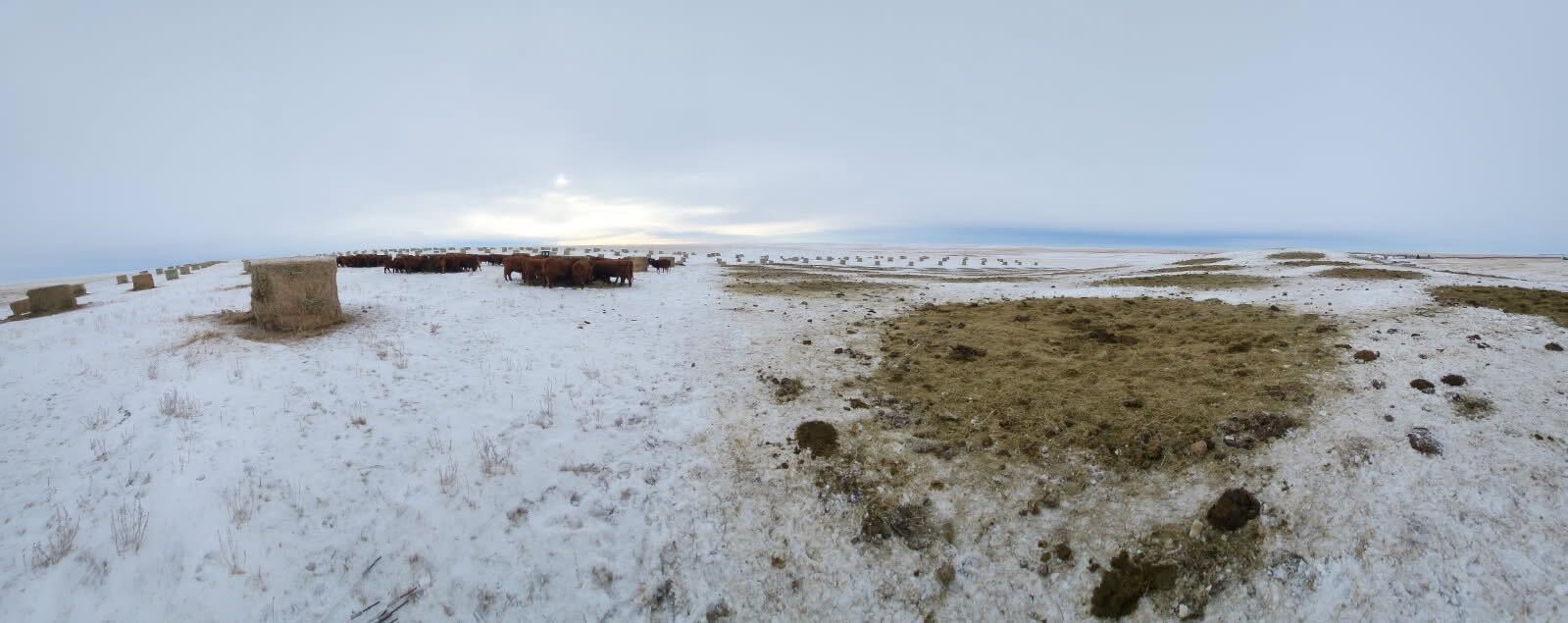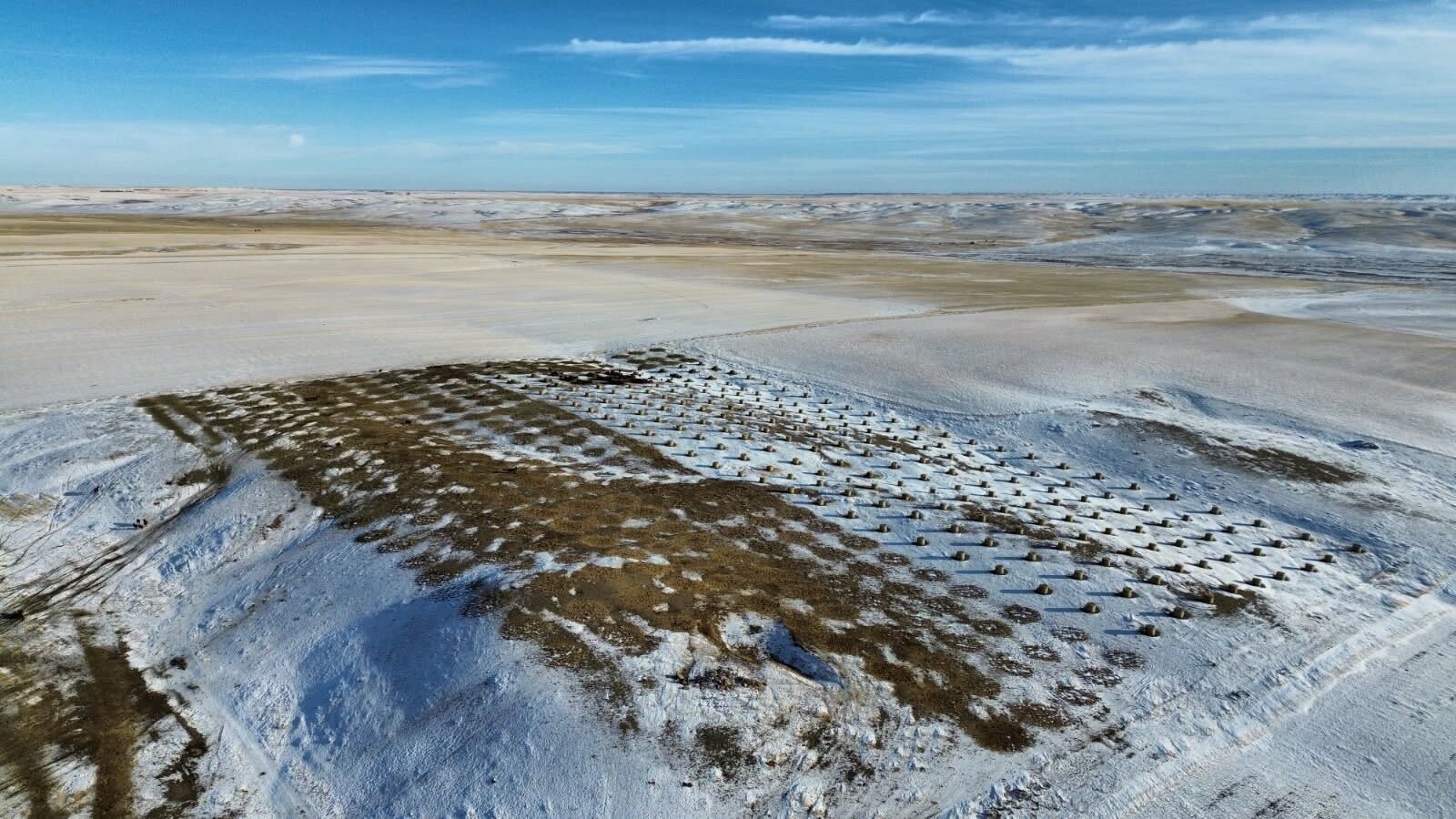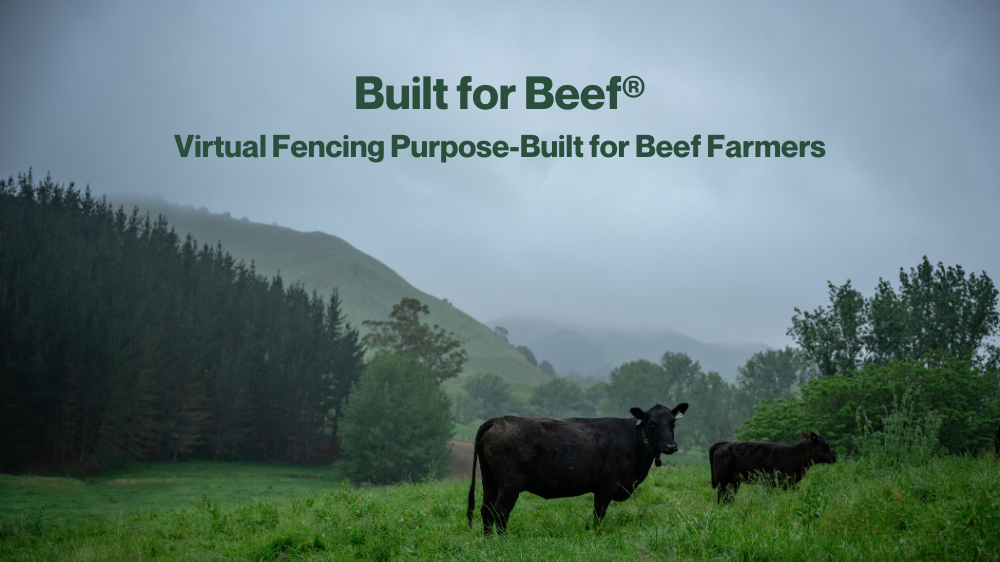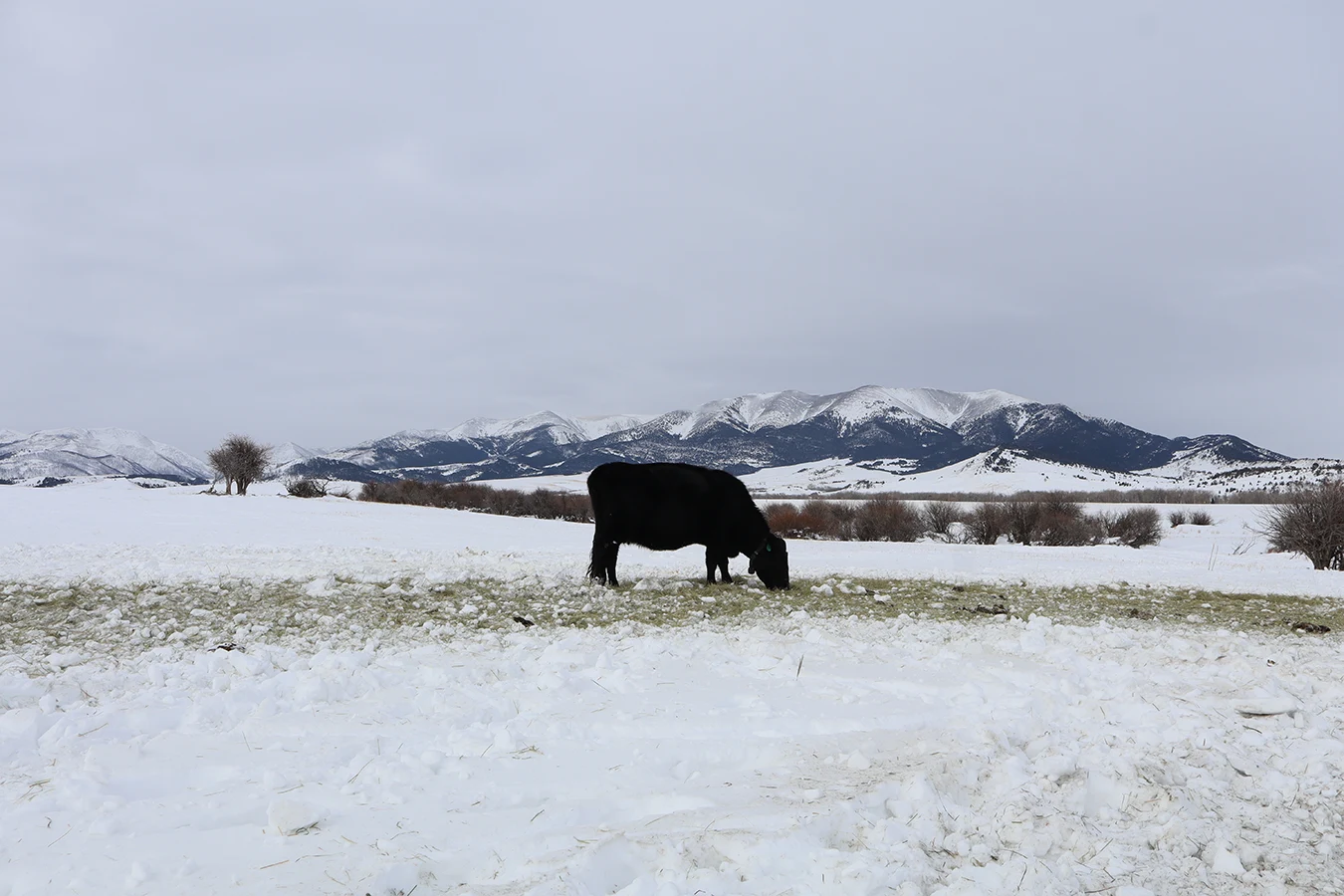Winter grazing strategies with virtual fencing: cut feed costs and extend your season
The first bale goes out before daylight. The second, after you check the water. By noon you're counting what's left in the stack, already running numbers in your head.
That's just winter, right?
Most of us do what's always been done: pen the cattle close, feed hay until the grass comes back. And it works. But it burns through hay faster than you'd like, and it's hard on your pastures.
There's a smarter way to get through winter. One that helps you make the most of the forage you've already got, takes pressure off your land, and trims that feed bill without cutting any corners on cattle care.
This guide covers winter grazing strategies that actually work, what it looks like when you add virtual fencing into the mix, and how to plan ahead so you're not scrambling when the weather turns.
Most ranchers start planning their winter grazing strategy in late summer or early fall. Here's what you need to know.

Why winter grazing matters
Feed is the single largest cost for most cow-calf operations. A typical 1,200-lb cow eats about 2–2.5% of her body weight in dry matter per day, which comes to roughly 30 lb of hay as-fed. Now multiply that across a 200-cow herd for the whole winter, and you're looking at around 450 tons of hay.
In 2024-2025, hay's running anywhere from $100 to $150 a ton, with most paying somewhere around $120 to $130. Do the math and you're staring down a feed bill between $45,000 and $67,500, and that's before you factor in fuel or your own time.
Even shaving two weeks off your hay feeding season can put thousands back in your pocket.
And it's not just the hay. Every cold start on the tractor costs you money. Fuel, wear and tear, repairs, they all add up fast when you're working in below-freezing temps. Virtual fencing lets you move cattle and open up new ground right from your phone, which means fewer frozen mornings wrestling with equipment and more of that machinery life left for when you really need it.
Putting proven grazing practices to work
Winter grazing isn't exactly new, but it takes planning the right setup to pull it off well. Short days, frozen ground, and unpredictable weather can make it tough to keep cattle moving the way you want them to.
That's where virtual fencing changes the game. Virtual fencing helps make your grazing plans work better, faster, and more efficiently. You can move your herd from the kitchen table, adjust pastures on the fly when the weather changes, and keep your grazing rotations going without fighting frozen ground or tangled wire in the cold.

Regional approaches
Mountain West and Northern Plains
If you're ranching in Montana, Wyoming, or the Dakotas, you know the drill. Snow and terrain pretty much dictate how long you're feeding. Some winters it's two months and some years it's seven.
A lot of ranchers up here already bale graze or swath graze to stretch their feed and make better use of manure. Virtual fencing just makes those systems easier to manage.
You pre-place your bales across multiple fields before winter hits, then use the Halter app to open up new sections every day or two, or even multiple times a day if you want, without ever touching a wire. It spreads your manure evenly, cuts way down on tractor time, and saves your best pastures for when spring finally rolls around.
For swath grazing, you can ration out those windrows in smaller sections, keep cattle exactly where you want them, and protect areas where you've got regrowth, all without trying to drive posts into ground that's frozen solid.
Southern Plains and Texas
In the southern plains, ranchers rely on stockpiled warm-season grasses like bluestem or bermuda through the colder months. Virtual fencing helps you ration those pastures way more precisely. You can open up new areas right from your phone and stretch that feed longer before you have to start rolling out hay.
It also takes the headache out of grazing cover crops like oats, rye, and brassicas. Instead of messing with temporary cross-fences (which nobody enjoys), you control access right in the Halter app. That means you can protect muddy spots, avoid pugging, and end up with better soil structure, steadier nutrition for your cattle, and a whole lot less daily hassle.
Southeast and Mid-South
If you're working with cool-season forages like fescue and ryegrass, you know they hold their quality pretty deep into winter. But wet soils can make it tough to keep cattle moving without damage.
Virtual fencing makes strip grazing way simpler because you can shift boundaries in seconds. That makes it actually realistic to move cattle frequently enough to cut down on trampling, protect your forage quality, and keep those rotations going well into late winter without turning your pasture into a muddy mess.

Key strategies for winter grazing
Bale grazing without wrecking a pasture
The approach is straightforward: spread your bales across the field before the snow flies, then use virtual fencing to open up a new strip at a time.
A lot of ranchers are moving cattle every day or two now because it takes minutes in the app. You end up with better manure distribution, less waste, and way fewer cold tractor starts.
Stockpiling and strip-grazing forage
Rest certain pastures in late summer or early fall so you can build up stockpile for winter. Cattle can graze through about a foot of soft snow if there's decent forage underneath, but ice crusting is usually where it stops working.
Virtual fencing helps you ration those acres precisely, so nothing gets trampled or wasted before you need it.
The real payoff shows up when spring hits:
- Less trampling and waste means more left for regrowth
- Better litter cover protects your soil
- Improved soil moisture and faster spring green-up
Grazing crop residue and cover crops
Rotating cattle across corn stalks, sorghum residue, or cover crops can cut your feed costs dramatically. Cover crops like oats, rye, and brassicas give your cattle quick energy from sugars, while residue adds the fiber and roughage they need.
Virtual fencing makes it simple to ration each field and move cattle around without setting up a single wire or post.
Using less-desirable or leftover forages
Virtual fencing helps hold cattle where they’d otherwise avoid: salt grass in the West, coarse fescue in the East, dormant stems in the South. Capturing those “leftovers” commonly adds 2–3 weeks of grazing while saving your best forage for calving or spring turnout.
Nutrition and efficiency
Rolling out hay all winter keeps cattle alive, but it's not a complete ration, and bale quality varies more than we'd like. Plus, cows burn a lot more energy just trying to stay warm.
When you mix in stockpiled grass, swaths, or cover crops, you lift the overall plane of nutrition and cut down on how much hay you actually need to feed.
Protecting soil and water
Here's something worth remembering: well-managed winter grazing actually builds soil health instead of beating it up.
Bale grazing and controlled rotations leave behind a mat of litter that shields the ground, slows runoff, and holds moisture for spring. Virtual fencing lets you rest riparian areas during thaws, rotate your feeding sites to avoid creating mud pits, and spread manure evenly across the ranch instead of concentrating it in one spot.
Better cover through winter means stronger regrowth when the weather finally turns.
Across most of the U.S., winter feeding can stretch anywhere from two to seven months. Virtual fencing helps you adjust your grazing plan to fit that window, stretching forage as long as weather allows and making the transition back to grass a wholelot smoother.
Frequently asked questions about winter grazing
Can cattle actually graze through snow?
Yep, typically up to about 12 inches if it's soft and there's forage underneath. Ice crusting is usually the limiting factor.
Does virtual fencing work in winter?
Absolutely. Halter collars are built for year-round use, and a lot of ranchers actually rely on them most during winter when daylight's short and moving cattle is harder than usual.
The collars were originally engineered to handle a New Zealand winter, which gets about six times less sunlight than most of the U.S. With solar panels built right in, there are no battery swaps to worry about, and they're proven to handle whatever weather you throw at them.
What's the best time to start winter grazing?
It depends on your region and forage type, but most ranchers begin when forage growth slows in late fall. In the Northern Plains, that's typically October-November. In the South, you might start as late as December. The key is starting before your stockpiled forage gets buried under snow or loses too much quality.
What equipment do I need for winter grazing?
The basics haven't changed: you need a way to test forage quality, monitor body condition, and provide mineral supplements. With virtual fencing, you eliminate the need for temporary posts, polywire, and energizers. The Halter collars handle the fencing, and you manage everything from your phone.
Making winter work for you
Winter feeding's always going to take effort. But virtual fencing changes the balance of that effort. It makes proven grazing practices practical, no matter what your climate throws at you.
If you’re looking to plan ahead for the season, a few things make a big difference:
- Assess forage supply early. Measure stockpile in the fall and set realistic graze-days.
- Decide on your feeding strategy. Bale grazing, stockpile grazing, or a planned mix.
- Pre-place bales before snow. It saves time, fuel, and tractor wear.
- Set up virtual fences in advance. Build your winter rotations in the app so you're prepared.
- Monitor cattle condition. Aim for a body condition score of 5–6 heading into calving and adjust rotations or supplementation as needed.
Ranchers across the country are already using virtual fencing to extend their grazing seasons by weeks, save thousands on hay and fuel, protect their soils and water, and make better use of the forage they've already got.
Winter grazing can work smarter, especially when you've got virtual fencing backing you up.
Want to see how it could work on your place? Book a call with our team and let's talk about how Halter can help you plan for this winter.
Related Blog Posts
See all articles
Built for Beef: How Halter Created Virtual Fencing Purpose-Built for Beef Farmers
Discover how Halter developed a virtual fencing system purpose-built for beef cattle. Learn how beef farmers have shaped the product, and the breakthroughs powering modern beef grazing management.
Read more
The science behind grazing at the third leaf stage
By hitting the right leaf stage, you can grow 10-15% more grass to substitute the costs on inputs.
Read more
How John Glass hit an 81% 6-week in-calf rate with Halter
John Glass has improved his six-week in-calf rate while lowering his empty rate to 10%. Before, he spent hours tracking heats manually—now, he just checks the app and follows the list. Halter also helps him manage pasture more effectively, keeping his herd well-fed and cycling properly.
Read more





